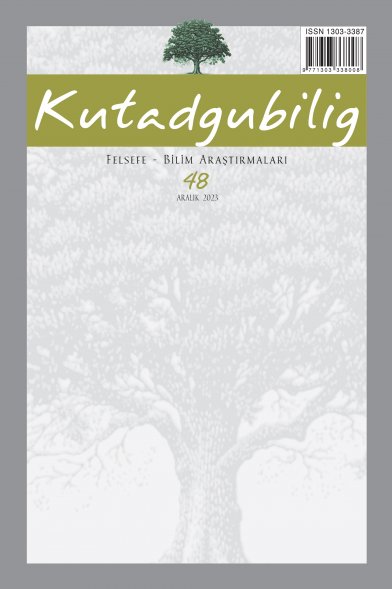ARİSTOTELES VE DESCARTES: METAFİZİK, BİLİM VE TEKNİK ARASINDAKİ İLİŞKİNİN DÖNÜŞÜMÜ
ARISTOTLE AND DESCARTES: TRANSFORMATION OF THE RELATIONSHIP BETWEEN METAPHYSICS, SCIENCE AND TECHNIQUE
___
Aristoteles; Metafizik, çev. A. Arslan. İstanbul: Sosyal Yayınları, 1996.Aristoteles; Fizik, çev. Saffet Babür. İstanbul: YKY, 2012.
Aristoteles; Nikomakhos’a Etik, çev. Zeki Özcan. Ankara: Sentez, 2014.
Aristoteles; “Generation of Animals”, The Complete Works of Aristotle Vol. 1., trans E. S. Forster, ed. Jonathan Barnes. New Jersey: Princeton University Press, 1991.
Burtt, Edwin Arthur; The Metaphysical Foundations of Modern Physical Science. London: Kegan Paul, Trench, Trubner & CO. LTD, 1925.
Capra, Fritjof; Batı Düşüncesinde Dönüm Noktası, çev. M. Armağan. İstanbul: İnsan Yayınları, 1992.
Cevizci, Ahmet; On Yedinci Yüzyıl Felsefesi. İstanbul: Say, 2013.
Cohen, Floris; “The Onset of the Scientific Revolution: Three Near-Simultaneous Transformations,” The Science of Nature in the Seventeenth Century: Pattern of Change in Early Modern Natural Philosophy, ed. Peter R. Ansety and John A. Schuster. Dordrecht: Springer, 2005.
Collingwood, Robin; The Idea of Nature. Oxford: The Clarendon Press, 1945.
Descartes, René; The Philosophical Writings Vol 1, eds. and trans. John Cottingham & Robert Stoothorf. Cambridge: Cambridge University Press, 1984.
Descartes, René; “İlk Felsefe Üzerine Meditasyonlar”, Söylem, Kurallar, Meditasyonlar, çev. A. Yardımlı. İstanbul: İdea, 1996.
Descartes, René; “Yöntem Üzerine Söylem”, Söylem, Kurallar, Meditasyonlar, çev. Aziz Yardımlı. İstanbul: İdea, 1996b
Dijksterhuis, Eduard Jan; The Mechanization of the World Picture: Pythagoras to Newton, trans. C. Dikshoorn. New Jersey: Princeton University Press, 1986.
Duhem, Pierre; To Save the Phenomena: An Essay on the Idea of Physical Theory from Plato to Galileo, trans. Edmund Dolan and Chaninah Maschler. Chicago: University of Chigaco Press, 1969.
Freely, John; The Emergence of Modern Science, East and West. İstanbul: Boğaziçi University, 2004.
Galilei, Galileo; Dialogues Concerning Two New Sciences, trans., H Crew and A. De Salvio. New York: William Adres Publishing, 2018.
Heidegger, Martin; “Matematik ve Metafizik,” Bilim Üzerine İki Ders, çev. Hakkı Hünler. İstanbul: Paradigma Yayınları, 1998.
Hesse, Mary B.; Forces and Fields: The Concept of Action at a Distance in the History of Physics. London; New York: T. Nelson, 1961.
Lovejoy, Arthur; Varlık Zinciri. İstanbul: İnsan Yayınları, 2002.
Koca, Engin; “Aristotelesçi Sistemde Fizik ve Sanat İlişkisi”, Divan Disiplinlerarası Çalışmalar Dergisi. Cilt 22, sayı 43 (2017/2), 1-23.
Koca, Engin; “Aristotelesçi Sistemde Pratik Sanatlar Bağlamında Teori ve Pratik İlişkisi”, Kutadgubilig Felsefe-Bilim Araştırmaları Dergisi, Sayı 37 (2018/1), 213-231.
Koyre, Alexandre; Bilim ve Devrim: Newton, çev. Nuri Küçük. İstanbul: Salyangoz Yayınları, 2006.
Kuhn, Thomas S.; Asal Gerilim: Bilimsel Gelenek ve Değişim Üzerine Seçme İncelemeler. çev., Yakup Şahan. İstanbul: Kabalcı, 1994.
Machamer, Peter, J. E.; Mcguire and Hylarie Kochiras. “Newton and the Mechanical Philosophy: Gravitation as the Balance of the Heavens.” The Southern Journal of Philosophy 50/III (2012): 370-88.
Meli, Domenico Bertoloni; Thinking with Objects: The Transformation of Mechanics in the Seventeenth Century. Baltimore: The Johns Hopkins University Press, 2006.
Roux, Sophie; “Cartesian Mechanics”, The Reception of the Galilean Science of Motion in Seventeenth-Century Europe, ed. C. R. Palmerino and J. M. M. H. Thijssen. Dordrecht: Springer, 2004.
Sarnowsky, Jürgen; “Concept of Impetus and the History of Mechanics,” Mechanics and Natural Philosophy Before The Scientific Revolution, ed. W.R. Laird and S. Roux. Dordrecht: Springer, 2008.
Schiefsky, Mark J.; “Art and Nature in Ancient Mechanics,” The Artificial and the Natural: An Evolving Polarity, ed. Bernadette Bensaude-Vincent and William R. Newman. Cambridge, Massachusetts London: The MIT Press, 2007.
Schuster, John A.; “Waterworld: Descartes’ Vortical Celestial Mechanics.” The Science of Nature in the Seventeenth Century: Pattern of Change in Early Modern Natural Philosophy, ed., P. R. Ansety and J. A. Schuster. Dordrecht: Springer, 2005.
Toulmin, Stephen; Foresight and Understanding. New York: Harper Torcbooks, 1961.
Westfall, Richard S.; Force in Newton’s Physics: The Science of Dynamics in the Seventeenth Century. New York: Science History Publications, 1971.
- ISSN: 1303-3387
- Yayın Aralığı: 2
- Başlangıç: 2002
- Yayıncı: Dergah Yayınları A.Ş.
DESCARTES’IN DOĞA FELSEFESİNİN MADDE KAVRAYIŞI
ADALET, SİYASET VE İYİ YÖNETİM: LİBERALİZMİN SÖYLEMSEL TAHAKKÜMÜNE BİR İTİRAZ
ELİTİST FELSEFE VE EZOTERİK DİKTATÖRLÜK: LEO STRAUSS ÖZELİNDE BİR TARTIŞMA
EPİKUROS’UN AHLÂK FELSEFESİNDE MUTLULUK KAVRAMI
ARİSTOTELES VE DESCARTES: METAFİZİK, BİLİM VE TEKNİK ARASINDAKİ İLİŞKİNİN DÖNÜŞÜMÜ
GENEL İLE ÖZEL ARASINDA OSMANLI TASNÎFU’L-ULÛM LITERATÜRÜNE GİRİŞ
UYGUR MANİHAİZMİ’NDE RUHLARIN KURTULUŞUNA AÇILAN KAPILAR: İKİ IŞIK SARAYI
